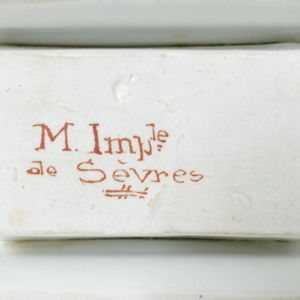French Sevres Ink Stand with Griffin Feet
A 19th century French Sevres ink stand, two ink pots and a square lidded pot to the centre, pen trays to either side, gilded griffin feet at each corner, green and gilded embellishments. Professional repair to foot. Height 12 cm, width 25.5 cm, depth 14 cm
You must be a subscriber, and be logged in to view price and dealer details.
Subscribe Now to view actual auction price for this item
When you subscribe, you have the option of setting the currency in which to display prices to $Au, $US, $NZ or Stg.
This item has been sold, and the description, image and price are for reference purposes only.
- Gilding - Gilding is a method of ornamentation whereby a thin sheet of gold metal is applied to items made of wood, leather, ceramics, glass and silver for decorative purposes.
For furniture including mirrors, the sheet of gold is usually applied over a coating of gesso. Gesso is a mixture of plaster of Paris and gypsum mixed with water and then applied to the carved wooden frames of mirrors and picture frames as a base for applying the gold leaf. After numerous coats of gesso have been applied, allowed to dry and then sanded a coat of "bole", a usually red coloured mixture of clay and glue is brushed on and allowed to dry, after which the gold leaf is applied. Over time parts of the gilding will rub off so the base colour can be seen. In water gilding, this was generally a blue colour, while in oil gilding, the under layer was often yellow. In Victorian times, gilders frequently used red as a pigment beneath the gold leaf.
Metal was often gilded by a process known as fire gilding. Gold mixed with mercury was applied and heated, causing the mercury to evaporate, the long-term effect of which was to kill or disable the craftsman or woman from mercury poisoning. The pursuit of beauty has claimed many victims, not the least of which were the artists who made those pieces so highly sought after today. - Griffin / Griffon / Gryphon - A griffin, also known as a griffon or gryphon, is a mythical creature with the body of a lion and the head of an eagle. It is typically depicted as a powerful and majestic beast, with the body and legs of a lion and the head, wings, and talons of an eagle. The griffin is widely recognized as a symbol of strength, courage, and guardianship, and has been used in a variety of cultures throughout history.
In ancient mythology, the griffin was often associated with the gods and was considered a symbol of divine power. In ancient Greece, for example, the griffin was associated with the sun god Helios, while in ancient Egypt, it was associated with the goddess Hathor. In medieval European heraldry, the griffin was used as a symbol of strength, valour, and protection, and was often featured on the coats of arms of noble families.
This item has been included into following indexes:
Visually similar items

Australian gold half sovereign 1866, Sydney, with AUSTRAIA reverse
Sold by
in
for
You can display prices in $Au, $US, $NZ or Stg.

Large Chinese painted calligraphy panel, 93 cm x 180 cm
Sold by
in
for
You can display prices in $Au, $US, $NZ or Stg.

A one troy ounce sterling silver ingot, wt 31grams
Sold by
in
for
You can display prices in $Au, $US, $NZ or Stg.

Victorian sterling silver cigarette box, London 1898, makers Hewson & Williams, lid with inscribed signatures and monogram dated 1922. Wood lined. Length 13.5 cm Height 6 cm. Weight 426grams (total).
Sold by
in
for
You can display prices in $Au, $US, $NZ or Stg.
